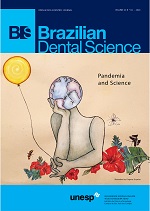Apical periodontitis in relation to radiographic quality of endodontic treatment in a selected adult Turkish population: A cross-sectional study
DOI:
https://doi.org/10.14295/bds.2020.v23i2.1874Abstract
Objective: The aim of this study was to examine the quality of root canal fillings and their relationship with apical periodontitis (AP) in a selected Turkish population. Material and Methods: The cases in this study was formed of patients attending routine dental treatment at the Faculty of Dentistry, University of Birun. 1024 patients were examined with panoramic radiographs and 1780 endodontically treated teeth with present periapical radiographs. Endodontic treatment quality was evaluated by obturation length, density, taper quality and iatrogenic errors. Presence of AP was analysed according to Ørstavik’s periapical index (PAI). The chi-square test was used for statistical analyses. Results: Statistically significant relationship was found between both the tooth type and location with obturation quality (p: 0.000; p < 0.05). Obturation quality of maxillary and mandibular molars are significantly less than the other tooth types in the same location. Apical periodontitis were noticed in 740 teeth (41.6%). Inadequate obturation quality was found to be significantly effective on the periapical status of tooth types both in maxilla and mandible (p < 0.05). Conclusion: The frequency of inadequate root canal obturations of endodontically treated teeth of the selected Turkish population was high, especially in molar teeth and women. Even though radiographic obturation quality is not the only success criteria in endodontic treatment, it is still one of the most important criteria regarding the positive correlation of “inadequate” obturations with AP.
KEYWORDS
Periapical periodontitis; Radiography; Root canal obturation; Root canal theraphy.
Downloads
Downloads
Published
How to Cite
Issue
Section
License
Brazilian Dental Science uses the Creative Commons (CC-BY 4.0) license, thus preserving the integrity of articles in an open access environment. The journal allows the author to retain publishing rights without restrictions.
=================




























